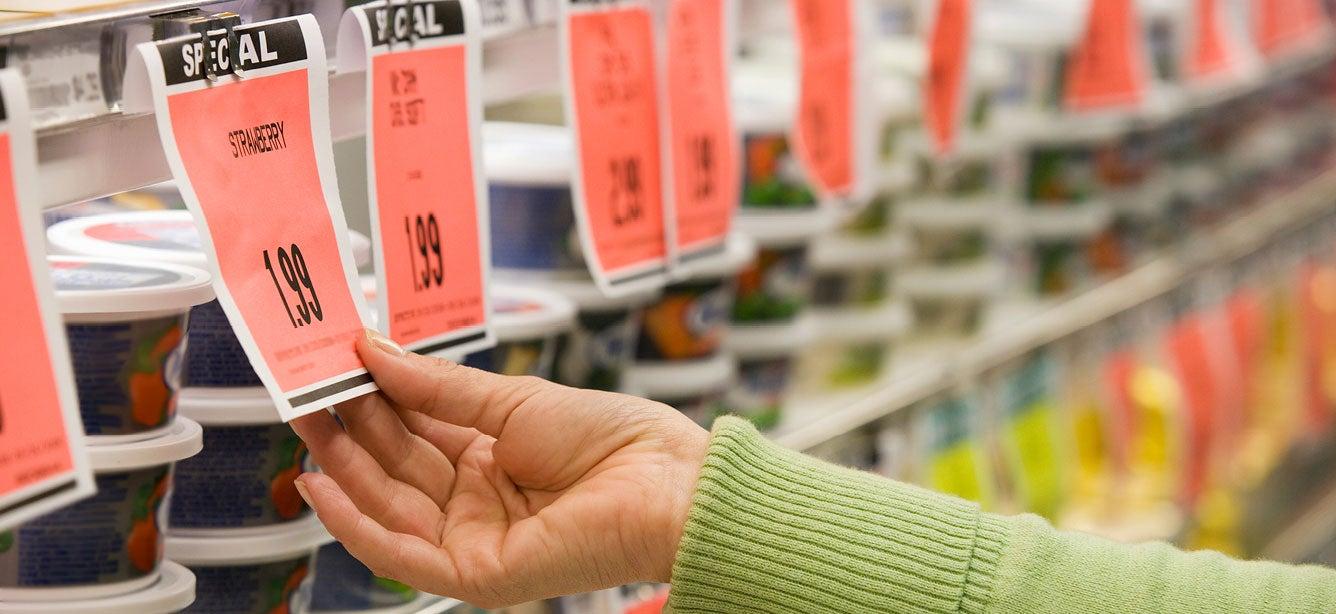
Related Topics
A staggering near-78% of responding U.S. adults live paycheck to paycheck, according to Payroll.org's 2025 Getting Paid in America survey.
Unsurprisingly, the same percentage of respondents pointed to rising inflation as the overwhelming culprit. In addition to using credit cards to bridge the gap, nearly 27% said they would delay paying bills in order to cover their weekly expenses.
“For many older adults who face this situation—whether they're still in the workforce or rely on Social Security—the impact is clear,” said Josh Hodges, NCOA's Chief Customer Officer. “Either they will forego other daily necessities, like prescription medicines, in order to pay for groceries; or they will buy less food and risk the effects of poor nutrition.”
If this sounds familiar, you’re not alone. People and families living on fixed or limited incomes are especially impacted by stubborn inflation. At the grocery store especially, costs continue to climb. Compared to a year ago, prices in the "food-at-home" category are up by 2.7%.1
That's why, during Boost Your Budget® Week every April and beyond, NCOA wants to empower you with strategies that can help absorb soaring food prices and better make ends meet.
Budget cuts older adults can make to save money immediately
First, you can potentially keep more money in your pocket by reducing certain expenses, including:
- Your cable plan: Most providers bundle your internet, TV, and land line. Consider choosing a different level of service; ask about price matching; and look into senior discount programs.
- Your home and car insurance premiums: You could save money when you opt for higher deductibles, bundle your policies with the same company, make home safety improvements, drive fewer miles, and more.
- Your cell phone service: If you don’t need unlimited data and texts, a pre-paid plan may be a budget-friendlier choice. You might also consider joining a friends and family plan if available.
- Discretionary spending: Many businesses offer age-based discounts on goods and services ranging from coffee to airline travel. Often, it’s simply a matter of asking at the time of purchase.
Second, you can—and should—take advantage of federal and state benefits programs specifically intended to help people with limited incomes pay for food. Millions of dollars in food assistance are available each year—and each year, older adults leave millions on the table. Why? “Because they don’t know about the programs, don’t realize they’re eligible to enroll, don’t know how or where to apply, or some combination of the three,” NCOA's Hodges said.
6 benefits programs that could help pay for food
1. The Supplemental Nutrition Assistance Program (SNAP)
Have you heard of Food Stamps? That’s SNAP—a monthly cash stipend, now distributed via an Electronic Benefits Transfer (EBT) card, that recipients can use to buy groceries at participating retailers.
Because SNAP is a federal program administered by each individual state, eligibility depends on where you live. That said, the average monthly benefit for enrolled older adults can approach or even exceed $100—an amount than can make a measurable difference when it comes to putting food on the table every day.
2. The Commodity Supplemental Food Program (CSFP)
Also known as the “Senior Food Box” program, this federal benefit provides a monthly package of groceries at no cost2 to enrollees. The United States Department of Agriculture distributes surplus commodity food and administrative funding to individual states, who then partner with public and nonprofit agencies to assemble and distribute the boxes. Common items include shelf-stable meats, fish, and vegetables, as well as canned fruit, dry beans, cereal, and other staples.
The Senior Food Box program is meant to fill in the gaps left by other food assistance programs. That means you can participate even if you already receive SNAP. Check with your local Agency on Aging, senior center, or even community health center to see if there’s a CSFP program near you.
3. The Seniors Farmers’ Market Nutrition Program (SFMNP)
Funded by the Farm Bill and administered in partnership with individual states, the SFMNP helps limited-income older adults buy fresh, locally grown vegetables, fruits, herbs, and honey at farmers’ markets, roadside stands, and community supported agriculture programs (CSAs). Seniors who already are enrolled in SNAP may automatically qualify for this program.
That said, state participation in SFMNP is voluntary, so you’ll need to check the USDA’s state agency contact map to see if there’s a program in your area.
4. The Home-Delivered Nutrition Program
Meals on Wheels is perhaps one of the best-known grantees of this federal program, which provides funding for community-based organizations to plan, prepare, and distribute free or low-cost meals to eligible older adults.
In general, there are no income requirements to qualify for the Home-Delivered Nutrition Program, but participants must be over the age of 60 and be at risk of losing their independence. The best way to find out about home-delivered meal programs near you, including specific eligibility requirements, is to contact your local Agency on Aging. Visit the Eldercare Locator to search online using your ZIP code.
5. The Emergency Food Assistance Program (TEFAP)
Whether or not you qualify for or receive SNAP benefits, you still may struggle to put food on the table. That’s where the Emergency Food Assistance Program comes in.
Funded federally, TEFAP directly supports food banks, food pantries, soup kitchens, and other community-based partners who feed people in need, including older adults. You don’t need an EBT card to participate; if you qualify, you can shop at your local food shelf or eat a meal in a congregate setting without having to exchange anything.
Generally speaking, qualifying for TEFAP is straightforward and the burden of proof is low. However, the process and requirements can vary depending on where you live, so it’s best to contact your State Distributing Agency for the most recent guidance in your area.
6. Visiting your local food banks
Though not an actual food assistance program, if you live on a fixed income, visiting a food bank is a smart decision—especially if you consider it as part of your overall meal-planning strategy.
“Make a point to visit the food bank before you go grocery shopping,” Hodges advised. “That way, the items you pick up there can inform your weekly menu, and anything you buy at the grocery store will supplement the recipes you’ve planned out, which can save you money at the register.”
And remember: there’s no rule preventing you from visiting more than one food pantry. You can locate those nearest you by visiting Feeding America’s website and typing your ZIP code into the search bar.
Get help understanding and applying for food benefits
Right now, an estimated 9 million older adults are are eligible for SNAP but not enrolled, according to NCOA data.
If you think you might qualify for one or more of these nutrition assistance programs, don’t hesitate to contact your local Benefits Enrollment Center (BEC). These community-based agencies exist to help you navigate and apply for all of the programs you may be eligible for, at no cost to you. Their services are confidential and benefits counselors have only your best interests in mind.
NCOA supports 87 BECs across 38 U.S. states. To find one nearest you, visit BenefitsCheckUp® and enter your ZIP code in the search bar at the top of the page.
Have questions about BenefitsCheckUp? We're here to help. Call NCOA's helpline at 1-800-794-6559, Monday through Friday from 8 a.m. to 7 p.m. ET.
More help for managing your finances
NCOA’s free Budget CheckUp tool offers advice on creating a monthly budget, decreasing expenses, and better managing your money. After you answer a brief anonymous quiz about your goals, Budget CheckUp provides a personalized plan of action.
Sources
1. U.S. Bureau of Labor Statistics. Consumer Price Index – September 2025. Found on the internet at https://www.bls.gov/news.release/pdf/cpi.pdf
2. USDA Food and Nutrition Service. Commodity Supplemental Food Program. Found on the internet at https://www.fns.usda.gov/csfp/commodity-supplemental-food-program






